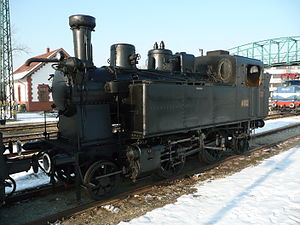MÁV series 22
| MÁV 22 MÁV series 275 |
|
|---|---|
|
lollipop
|
|
| Numbering: | 22.001-148 275.001-148 |
| Number: | MAV: 148 JDŽ: 22 |
| Manufacturer: |
MÁVAG , Budapest Machine works Slavonski Brod , Slavonski Brod |
| Year of construction (s): | 1928-1940 |
| Retirement: | MAV: around 1975 |
| Axis formula : | 1'B 1'h2t |
| Gauge : | 1435 mm ( standard gauge ) |
| Length over buffers: | 8,860 mm |
| Height: | 3,816 mm |
| Total wheelbase: | 6,000 mm |
| Service mass: | 35.9 t |
| Friction mass: | 18.4 t |
| Wheel set mass : | 10 t |
| Top speed: | 70 km / h |
| Starting tractive effort: | 31.4 kN |
| Driving wheel diameter: | 1,220 mm |
| Control type : | Heusinger |
| Number of cylinders: | 2 |
| Cylinder diameter: | 335 mm |
| Piston stroke: | 460 mm |
| Boiler overpressure: | 14 bar |
| Grate area: | 1.25 m² |
| Superheater area : | 17 m² |
| Evaporation heating surface: | 49 m² (in contact with water) |
| Water supply: | 4 m³ |
| Fuel supply: | 1.3 t |
| Brake: | Handbrake block brake |
The MÁV series 22 , from 1957 MÁV series 275 , was a tank locomotive series of the Hungarian State Railways MÁV for branch line traffic. It was developed for light passenger trains on branch lines with a light superstructure in the timetable for diesel ( motor ) railcars and was therefore referred to as an engine replacement steam locomotive .
history
In the economically difficult years 1920–1930, the Hungarian state railways MÁV separated freight and passenger traffic on branch lines. Passenger trains should be transported with light and relatively fast steam locomotives, if not with multiple units.
After the modernization of some wet steam locomotives acquired around 1910, this tank locomotive appeared around 1928, with which trains could be transported in both directions at the same speed.
Various information about the vehicles actually produced can be found in the literature. It is clear that the locomotives for MÁV in MÁVAG were produced.
The vehicles were popular locomotives and served for over 50 years. They were able to move a load of 120 t at 70 km / h and 160 t at 60 km / h on a flat stretch. In the 1930s they also ran express trains with a load of 120 t between Budapest and Balatonfüred during the season . They were nicknamed Lollipops by the company service . It was only the progressive dieselization on the branch lines that made them dispensable, although the data for the decommissioning cannot be found in the literature. The 22.034 was renewed in 1985 in the Landler depot and has been available for nostalgic train operations ever since. In addition, some locomotives have been preserved as non-operational examples. The 275.064, 275.120 and 275.118 are known.
technical features

The locomotive is a superheated steam twin engine with two coupled wheel sets. There were some differences in the design of the steam engine; a third of the locomotives were equipped with a copper fire box, a further third with a fire box with a vaulted ribbed ceiling and a further third with a steel fire box. The ratio of 1:39 between the grate and the boiler heating surface in contact with water shows that the locomotives were designed for the use of coal with a lower calorific value.
The drive was designed with running axles of the Adams-Webb type . It enabled the locomotive to run smoothly even at 85 km / h, which was achieved on test drives.
The axle pressure could optionally be changed between 9 t and 10 t.
The 22 series in Yugoslavia
Yugoslavia got the manufacturing rights for these locomotives, and the other machines were manufactured by the machine works Slavonski Brod in Slavonski Brod . There the type was further developed, and the vehicles also received valve control.
The use of the machines and the history of the machines in the JŽ cannot be found in the literature.
See also
literature
- General Directorate of MAV , Autonomous Department for Press, Advertising and Propaganda (Ed.): Railway nostalgia in Hungary . Hungaria Sport Egri Nyomda, Eger 902436.
- Mihály Kubinszky (Ed.): Hungarian Locomotives and Railcars , Akadémiai Kiadó, Budapest, 1975, ISBN 963-05-0125-2 .
- Tibor Wein: Railway Noise of the Past , Közlekedési Múzeum , Budapest
